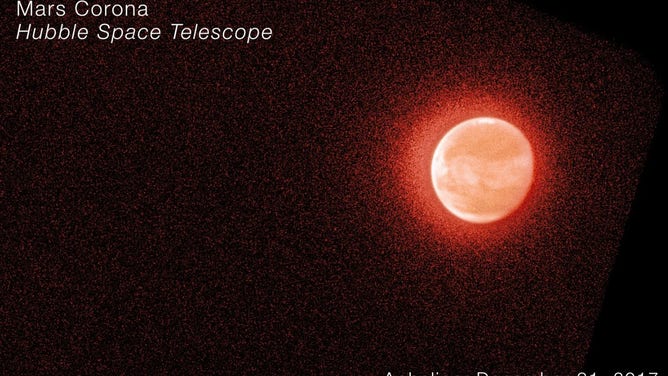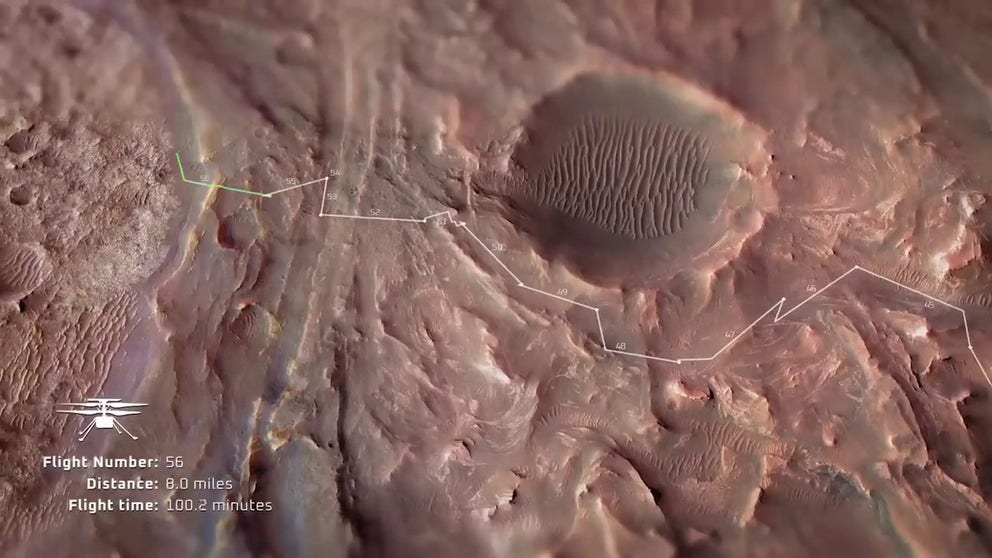Clues behind Mars’ water loss mystery revealed by researchers
Mars is about half the size of Earth and has an extensive volcano system. Mars is thought to have formed some 4.6 billion years ago and is the most explored planet in the solar system. According to NASA, Mars’ atmosphere is made up of 95% carbon dioxide, 2.7% nitrogen, 1.6% argon and 0.13% oxygen. Due to the composition, the atmosphere is not thick enough to trap heat, so temperatures are thought to range from more than -200 degrees Fahrenheit below zero to only about 80 degrees in direct sunlight.
'Wintry' scenes from Mars: How the Red Planet sometimes looks a little white
It's not just Earth that boasts snowfall. Mars gets snow sometimes too, only there, it's frozen carbon dioxide, not water. Peek at some of the "snowy" scenes from our distant planetary neighbor.
Data collected by the Hubble Space Telescope and NASA’s Mars Atmosphere and Volatile Evolution mission are providing new insights into the history of water on the Red Planet.
Scientists have long thought Mars was a wet planet with terrain features such as trenches and valleys showing signs of once containing a liquid substance.
But over several billion years, the water has disappeared, leading to scientists’ quest to figure out where it has gone.
"There are only two places water can go. It can freeze into the ground, or the water molecule can break into atoms, and these atoms can escape into space," John Clarke, a member of the study from the Center for Space Physics at Boston University, said in a statement. "To understand how much water there was and what happened to it, we need to understand how these atoms escape into space."
Clarke said his team focused on estimating the escape rates of hydrogen and deuterium to gauge the history of water on Mars.
By studying the chemicals, researchers can infer how much water was once present on the Red Planet.
JAMES WEBB SPACE TELESCOPE WON’T BE RENAMED FOLLOWING INVESTIGATION INTO GOVERNMENT DISCRIMINATION

Hubble image of Mars near its farthest point from the Sun on December 31, 2017.
(NASA)
The research team found that escape rates of hydrogen and deuterium fluctuate significantly depending on how close the fourth planet is to the Sun.
Additionally, the team’s findings suggested the process required additional energy, such as collisions with protons or chemical reactions driven by sunlight.
"In recent years, we’ve discovered that Mars’ atmosphere is much more dynamic than previously thought," Clarke stated. "The whole atmosphere changes rapidly, heating up and cooling down on short timescales. This variability affects how quickly water molecules rise and break apart."
The group did not publicly state how much water they believe once existed on the planet, indicating that future research will likely be underway.
SEE THE OBJECT HUMANS LEFT BEHIND ON THE MOON
Understanding Mars’ water loss is considered to be crucial for not only understanding the planet’s 4.6-billion-year history but also drawing up potential exploration plans for the solar system’s fourth planet.
NASA previously announced a goal to send astronauts to the Red Planet as early as the 2030s, but that self-imposed deadline may be slipping due to recent technical and budgetary issues.
Recently, a four-person crew completed a year-long project simulating spacewalks, experiments, and other activities intended for the Martian surface.
On average, the planet is about 140 million miles away from Earth, meaning a round-trip mission and stay would take several years to complete.
Watch Ingenuity helicopter's 72 flights on Mars
Designed to be a technology demonstration that would take five flights in 30 days, NASA's Ingenuity helicopter eventually flew more than 14 times farther and logged more than two hours of total flight time. This video shows all 72 flights on Mars, including the final flight on Jan. 18, 2024. (Video: NASA/JPL-Caltech)

